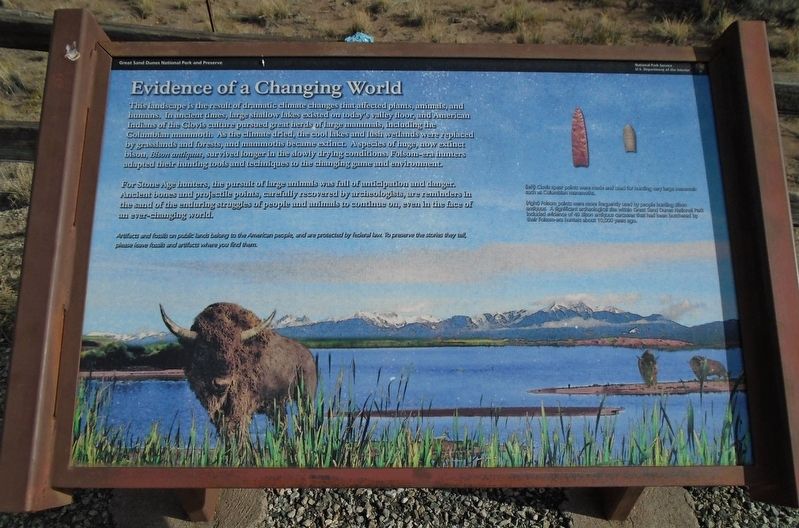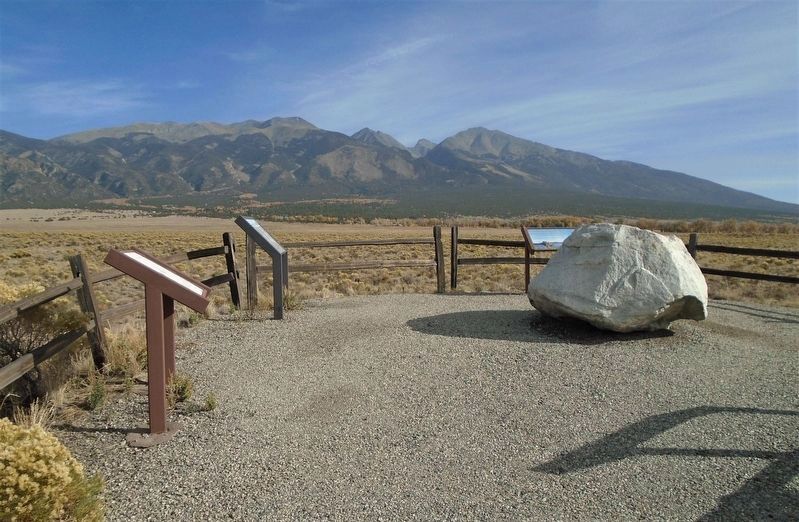Evidence of a Changing World
This landscape is the result of dramatic climate changes that affected plants, animals, and humans. In ancient times, large shallow lakes existed on today's valley floor, and American Indians of the Clovis culture pursued great herds of large mammals, including the Columbian mammoth. As the climate dried, the cool lakes and lush wetlands were replaced by grasslands and forests, and mammoths became extinct. A species of huge, now extinct bison, Bison antiquus, survived longer in the slowly drying conditions. Folsom-era hunters adapted their hunting tools and techniques to the changing game and environment.
For Stone Age hunters, the pursuit of large animals was full of anticipation and danger. Ancient bones and projectile points, carefully recovered by archeologists, are reminders in the sand of the enduring struggles of people and animals to continue on, even in the face of an ever-changing world.
[Top right photo captions read]
(left) Clovis spear points were made and used for hunting very large mammals such as Columbian mammoths.
(right) Folsom points were more frequently used by people hunting Bison antiquus. A significant archeological site within Great Sand Dunes National Park included evidence of 49 Bison antiquus carcasses that had been butchered by their Folsom-era hunters about
10,000 years ago.
Artifacts and fossils on public lands belong to the American people, and are protected by federal law. To preserve the stories they tell, please leave fossils and artifacts where you find them.
Erected by National Park Service.
Topics. This historical marker is listed in these topic lists: Animals • Anthropology & Archaeology.
Location. 37° 39.736′ N, 105° 36.089′ W. Marker is near Mosca, Colorado, in Alamosa County. Marker is on Lane 6N, 1.2 miles west of State Highway 150, on the left when traveling west. Marker is at a scenic overlook, a short walk from a roadside pulloff. Touch for map. Marker is in this post office area: Mosca CO 81146, United States of America. Touch for directions.
Other nearby markers. At least 8 other markers are within 7 miles of this marker, measured as the crow flies. L.B. "Bill" Casselman (here, next to this marker); Understanding the Great Sand Dunes System: the Sand Sheet (here, next to this marker); Understanding the Great Sand Dunes System: the Sabkha (here, next to this marker); Sounds of Silence (here, next to this marker); Pike and Southwest Commerce (approx. 1.8 miles away); "Totally Unique and Unexpected" (approx. 3.8 miles away); A Landmark for People (approx. 4.7 miles away); Zebulon Pike's "sand-hills" (approx. 6.7 miles away). Touch for a list and map of all markers in Mosca.
Also see . . .
1. Great Sand Dunes National Park History & Culture. (Submitted on November 22, 2020, by William Fischer, Jr. of Scranton, Pennsylvania.)
2. Great Sand Dunes eolian system archaeological program research (George Wright Society). (Submitted on November 22, 2020, by William Fischer, Jr. of Scranton, Pennsylvania.)
3. Great Sand Dunes National Park & Preserve Geologic Resource Evaluation Report. (Submitted on November 22, 2020, by William Fischer, Jr. of Scranton, Pennsylvania.)
4. Are These Mysterious Great Sand Dunes Stones Musical? When You Hear It, ‘You Believe It’ (CPR, 2018). (Submitted on November 22, 2020, by William Fischer, Jr. of Scranton, Pennsylvania.)
Credits. This page was last revised on November 22, 2020. It was originally submitted on November 22, 2020, by William Fischer, Jr. of Scranton, Pennsylvania. This page has been viewed 146 times since then and 7 times this year. Photos: 1, 2. submitted on November 22, 2020, by William Fischer, Jr. of Scranton, Pennsylvania.

